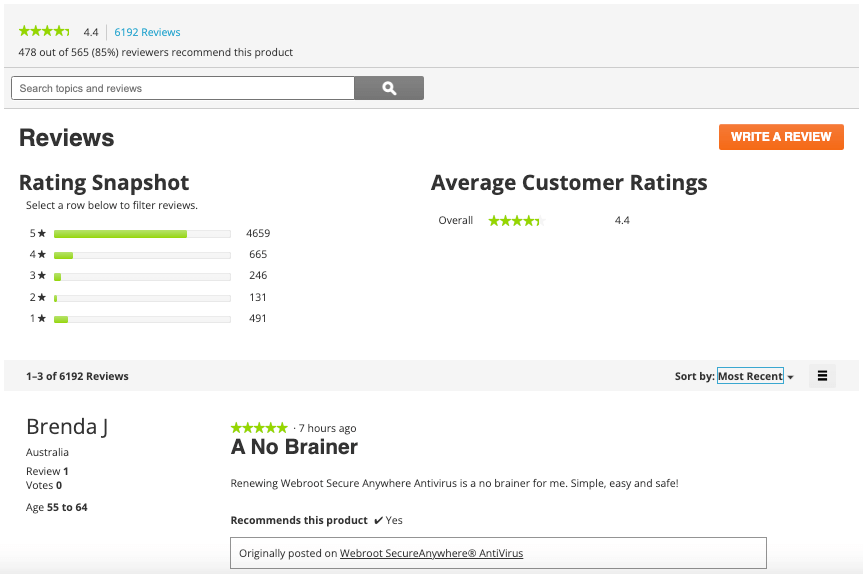
Webroot verbessert die Kundenerfahrung mit direkten Antworten auf Bewertungen
Beantwortung von Bewertungen und Käuferfragen über Connections bringt Webroot einen Wettbewerbsvorteil.
Mehr dazu
Software
Ein besserer Kundenservice, mehr Umsatz und wertvolle Erkenntnisse für die weitere Geschäftsentwicklung: Der führende Anbieter für Cybersicherheit profitiert gleich in mehrfacher Hinsicht von Kundenbewertungen.

Auf einen Blick
Wenig Kundenbewertungen auf Websites von Partnern im Handel, eine geringe Antwortrate bei niedrigen Bewertungen und nur wenig wertvolles Kundenfeedback zur Produktoptimierung: Dagegen wollte Webroot etwas tun.
Mit der Implementierung von Review Syndication und Bazaarvoice Connections konnten die Zahl der Bewertungen und die Antwortrate kanalübergreifend erhöht werden. Zur weiteren Produktverbesserung kam außerdem die Lösung „Insights & Reports“ zum Einsatz.
Seit der Implementierung stieg die Zahl der Bewertungen um 9.168 % und die Antwortrate auf Bewertungen mit wenigen Sternen um 97,9 %, wodurch weniger Kunden abwanderten.
ERHÖHEN SIE DAS REZENSIONSVOLUMEN
Webroot ist ein Spezialist für Online-Datenschutz und -Sicherheitslösungen und sowohl im B2B- als auch im B2C-Geschäft tätig. Mit seinen Lösungen sorgt Webroot dafür, dass seine Kunden gegen vielfältigste Arten von digitalen Bedrohungen oder Datenverlusten gefeit sind. 2019 wurde Webroot (und seine Muttergesellschaft Carbonite) vom führenden Anbieter für Enterprise Information Management, OpenText, übernommen.
Ein starker Indikator für den Erfolg und die Glaubwürdigkeit von Webroot ist der loyale Kundenstamm. „Wenn Kunden erst einmal auf das Ökosystem von Webroot umgestiegen sind, ein oder zwei Produkte nutzen und uns ein paar Jahre kennen, steigt die Tendenz, dass sie uns für immer treu bleiben“, so Keenan Humphrey, Community Manager bei Webroot.
So geben die Kunden selbst auch immer wieder an, dass sie großes Vertrauen in das Unternehmen, seine Dienstleistungen und Produkte setzen.  Das zeigt sich auch in den unzähligen positiven Bewertungen. Leider erreichte Webroot mit diesem aussagekräftigen User-Generated Content (UGC) bislang aber nur einen Bruchteil der Kanäle, über die das Unternehmen seine Produkte vertreibt. Hinzu kam noch das Problem, dass die Anzahl der Bewertungen für das eher kleine Kundensupport-Team zu hoch war, um sie mit dem bestehenden System zu verwalten.
Das zeigt sich auch in den unzähligen positiven Bewertungen. Leider erreichte Webroot mit diesem aussagekräftigen User-Generated Content (UGC) bislang aber nur einen Bruchteil der Kanäle, über die das Unternehmen seine Produkte vertreibt. Hinzu kam noch das Problem, dass die Anzahl der Bewertungen für das eher kleine Kundensupport-Team zu hoch war, um sie mit dem bestehenden System zu verwalten.
Daher blieben viele Bewertungen, die weitere Fragen oder Bedenken enthielten, unbeantwortet, und wertvolle Einblicke, die zur Produktverbesserung hätten genutzt werden können, gingen verloren. Der Wunsch nach mehr Sichtbarkeit und einer besseren Verwaltung und Analyse der Kundenbewertungen war schließlich der Grund für Webroot, sich an Bazaarvoice zu wenden.
Partnerschaften im Einzelhandel sind für den Erfolg der Verbraucherprodukte von Webroot von entscheidender Bedeutung. Eine der stärksten Partnerschaften war bislang die Zusammenarbeit mit Best Buy. „Mit Best Buy pflegen wir für unsere Verbraucherprodukte eine langjährige Partnerschaft im Einzelhandel“, so Humphrey. „Unsere Verkaufszahlen bei Best Buy waren immer gut. Dafür waren wir leider überall sonst nicht besonders präsent.“ Die Syndizierung von Kundenbewertungen über Best Buy hinaus an andere wichtige Einzelhändler wie Walmart und Staples war für Webroot eine bahnbrechende Maßnahme. „Die Tatsache, dass wir die Beliebtheit auf der Best Buy-Plattform nutzen und einen Teil dieses Werts auf andere Händlerwebsites übertragen können, hat definitiv einen großen Teil zur besseren Sichtbarkeit und einem höheren Umsatz beigetragen“, so Humphrey.
Dank Retail Syndication erreicht Webroot die Verbraucher durch eine Vielzahl authentischer Bewertungen auf allen Partnerwebsites, auf denen seine Produkte verfügbar sind. Im Vergleich zu anderen Netzwerken greifen auf das unübertroffene, mehr als 1.750 Einzelhändler weltweit starke Netzwerk von Bazaarvoice zwanzig Mal mehr Käufer auf Inhalte zu.
Durch die Nutzung dieses Services erhält Webroot viel mehr Aufmerksamkeit für seine Produktbewertungen, was die Konversionsrate auf den Produktseiten erheblich steigern kann. In den letzten zwölf Monaten stieg die Zahl der Bewertungen für Webroot-Produkte auf Websites um 9.168 %. 
Ein weiterer Aspekt, in dem Humphrey und sein Team sich verbessern wollten, war der Umgang mit den Bewertungen selbst. Mit dem Bazaarvoice-Tool Ratings & Reviews und dem darin enthaltenen Connections-Feature konnte das Team sein Vorhaben, „die Antwortrate und Reaktionszeit bei Kundenbewertungen zu verbessern“, erfolgreich in die Tat umsetzen.
Das Webroot-Team nutzt die Filteroption innerhalb der Workbench-Funktion des Tools, um so schnell wie möglich auf die wichtigsten Bewertungen reagieren zu können.
Das Ergebnis:
„Ich glaube, dass das Vertrauen der Kunden in uns dadurch enorm gestiegen ist“, so Humphrey. Das Team kann nun rasch auf sämtliche Bewertungen mit einem bis drei Sternen reagieren, Probleme schneller aus der Welt schaffen und seine Kunden besser halten. Und das ist auch wichtig: 87 % der Kunden, die eine negative Bewertung abgeben, erwarten heute eine Antwort oder weitere Maßnahmen von den betreffenden Unternehmen.
Daneben enthalten Kundenbewertungen aber immer auch wertvolles Feedback. Durch die Analyse von Bewertungen kann das Webroot-Team Probleme feststellen und Lösungen ermitteln. Dazu gehört zum Beispiel, dem Kunden bei der Fehlerbehebung zu helfen oder ihn an den richtigen Ansprechpartner des Vertriebsteams oder an den technischen Support zu verweisen. Webroot kann auf diesem Wege auch über den Status von Support-Tickets und andere relevante Einzelheiten informieren.
Eine zentrale Säule für den Erfolg des UGC-Programms von Webroot sind die Insights and Reports von Bazaarvoice. „Zu den größten Vorteilen der Bazaarvoice-Plattform zählt, dass wir Daten organisieren und nachverfolgen können“, meint Humphrey. „Das Insights-Tool ist wirklich äußerst nützlich. Damit verbringe ich wahrscheinlich den Großteil meiner Zeit.“
Humphrey verwendet Daten zur Kundenstimmung aus unseren Insights-Tools und präsentiert sie anderen Abteilungen und Stakeholdern des Unternehmens, um Geschäftsentscheidungen zu validieren und zu begründen. Dank der Insights kann das Team Trends in den Daten aufspüren und z. B. immer wiederkehrenden Kundenfragen und -beschwerden leichter auf den Grund gehen.
Bei neuen Produktversionen und -updates kann es zudem genau beobachten, wie sich die Bewertungen der Kunden und die Stimmung allgemein verändern. Webroot hat zu jeder Zeit den Überblick, was bei seinen Kunden ankommt und was sie vom aktuellen Produktangebot halten. „Das ist etwas Handfestes, das ich an viele Abteilungen von der Produktion bis hin zum Produktmarketing weitergeben kann und das aufzeigt, ob eine Neuerung das gebracht hat, was wir beabsichtigt haben“, so Humphrey.
Dank dieser Art von Kundenfeedback bleibt Webroot flexibel und kann schneller handeln. So konnte das Unternehmen beispielsweise die Performance eines großen Updates für seine mobile App verbessern, das den negativen Bewertungen zufolge zunächst schlecht aufgenommen worden war. Anhand dieser Daten wurden Anmerkungen und Zeitpläne mit den Teams für die Entwicklung und den Support der mobilen App abgeglichen.
Die Möglichkeit, die Leistung von Webroot mit der von Mitbewerbern innerhalb der Branche zu vergleichen, ist Humphrey zufolge ein weiterer wichtiger Vorteil der Insights-Tools. Dank des „ungeschönten Blicks, den diese Tools uns erlauben“, kann das Unternehmen Wachstumschancen besser erkennen.
So kann Webroot einerseits seine Produkte mit neuen Erkenntnissen und Fachwissen optimieren und andererseits auch die Kundenerfahrung proaktiv gestalten. Dank Bazaarvoice verhindert das Team bei Webroot inzwischen viele Probleme, noch bevor sie entstehen. Humphrey leitet auch die Webroot Community, in der er FAQs und Tutorials als wertvolle Kundenressourcen zur Verfügung stellt. Selbst Kunden, die nicht der Community angehören, können auf diese Informationen zugreifen, die unter den relevanten Suchergebnissen angezeigt werden.
Es sind nicht nur die Produkte und Lösungen von Bazaarvoice, die einen Unterschied machen. Das Beste an der Zusammenarbeit mit Bazaarvoice ist für Humphrey das Customer Success Management. Diese Art von Feedback erhalten wir besonders gerne. Es ist immer schön, positives Feedback über unsere Mitarbeiter zu hören.
Basierend auf dem Fachwissen und Service unserer Customer Success Manager verfügt das Webroot-Team über alle nötigen Tools und Kenntnisse, um seine Performance und Daten zu verstehen. „So haben wir eine wirklich solide Feedbackschleife geschaffen, die dazu auch noch sehr einheitlich ist.“
Treten Sie hier mit uns in Kontakt, um zu erfahren, was die Zusammenarbeit mit Bazaarvoice so besonders macht.
ERHÖHEN SIE DAS REZENSIONSVOLUMEN

Indem wir das viele positive Feedback, das wir bei Best Buy bereits hatten, nun auch zum Teil auf anderen Partner-Websites nutzen, sind wir deutlich sichtbarer geworden – und unsere Umsätze sind signifikant gestiegen.
Keenan Humphrey
Community Manager bei Webroot
Bazaarvoice unterstützt Sie dabei, Ihre Geschäftsziele zu erreichen und Ihr Unternehmen zum Erfolg zu führen.